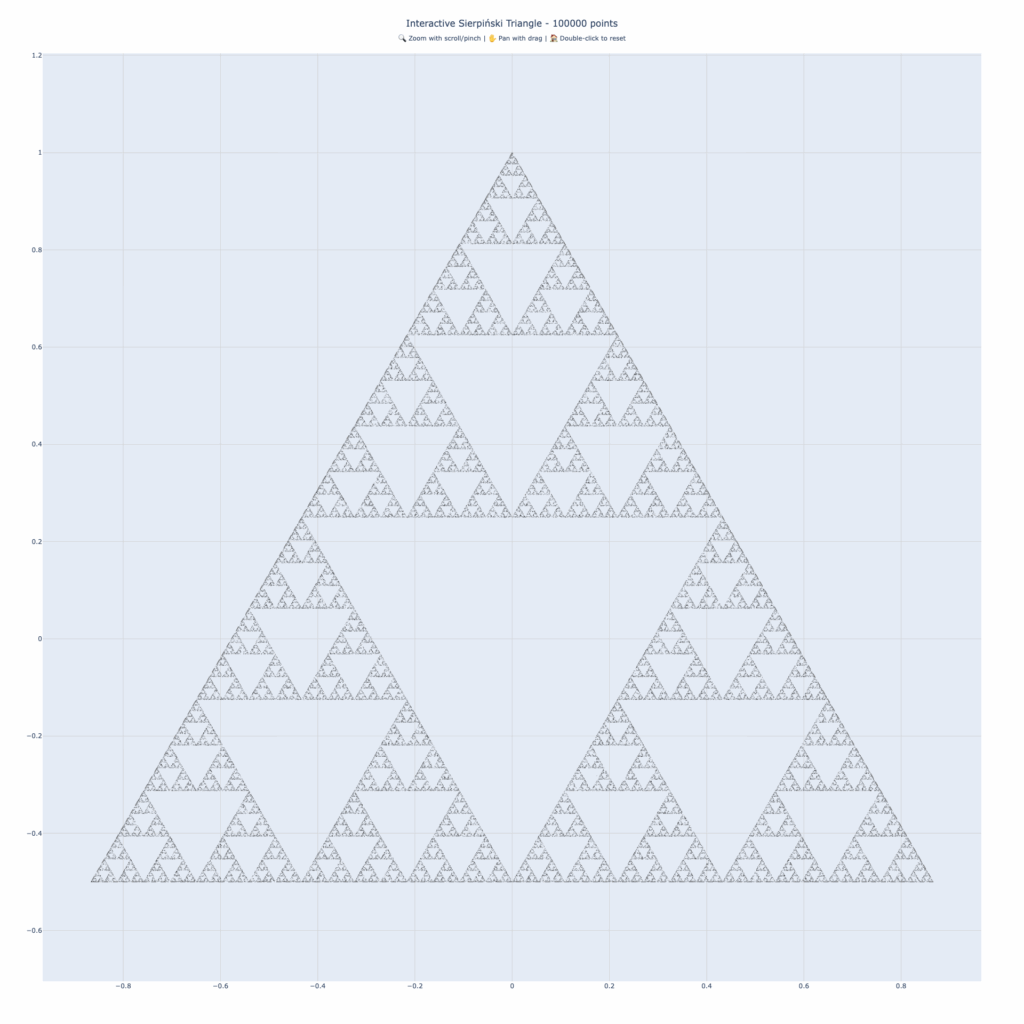Ever since childhood, I loved geometry classes even though I hated math. I always used to carry a protractor and compass to draw random shit on my notebook – it was fun. The more I played around, the more I realized I loved patterns, and so the journey began.
Like you might guess, I was watching a random YouTube video at 3 am and came across this triangle stuff, and I was like “wait a minute, this is AMAZING.” Since I’ve been taking numerous product management classes and working on an AI project at ITS Northeastern, I’ve noticed a pattern.
Guess what? User Research.
I know, I know… you may be like “what the fuck is up with triangles and user research, let alone product management?” XD
Hear me out – that ‘trust me bro’ moment.
What the Hell is a Sierpiński Triangle?
Imagine you’re playing the world’s weirdest game of connect-the-dots. You start with three points forming a triangle, that’s it, your whole playing field. Now here’s where it gets trippy: you drop a random dot anywhere, pick one of the three corners at random, and move halfway from your dot to that corner. Plot that point. Now from this new point, pick another random corner, go halfway again. Plot. Repeat this seemingly pointless exercise 10 times and you’ve got… random dots. Nothing special. But here’s the wow moment – do this 10,000 times, or 100,000 times, and suddenly, out of pure randomness and chaos, a perfect fractal pattern emerges. The Sierpiński triangle reveals itself: an infinite pattern of triangles within triangles within triangles. It’s like the universe is playing a joke on us – “Hey, want to see me make perfect order from complete randomness?” This thing appears everywhere in nature, from seashells to mountain ranges, and mathematicians have been obsessed with it since 1915. The best part? Those empty triangular spaces you see in the pattern? They’re “forbidden zones” – no matter how many millions of points you plot, you’ll NEVER land in those spots. It’s mathematics saying “these areas are off-limits” through pure probability.
The Chaos Game of Product Discovery
Like this Sierpiński triangle – one or even 20 points in the triangle didn’t reveal shit. It was just random dots. But the more data you start collecting, the sharper the picture gets. I feel this is the same with any research or product ideation.
Think about it:
- First 10 user interviews: “Everyone wants different things, this is chaos!”
- 50 interviews: “Wait, I’m hearing some similar pain points…”
- 100 interviews: “Holy shit, there’s a clear pattern here!”
- 500+ interviews: The product requirements practically write themselves
Having done proper user research is utmost important to find the pattern of the problem or the solution. It’s literally the Chaos Game – each user interaction is like choosing a random corner and moving halfway there. Seems random as fuck at first, but keep iterating and boom – your product-market fit emerges like a beautiful fractal.
The Lean Startup Connection
The importance of lean startup ideas and feedback loops suddenly makes SO much sense when you think about it this way. Each iteration in the Build-Measure-Learn cycle is like adding more points to our triangle:
- Build: Pick a random feature hypothesis (choose a corner)
- Measure: Ship it to users (find the midpoint)
- Learn: Collect data (plot the point)
- Repeat: Keep iterating until the pattern emerges
You might be wondering what this guy is smoking… Well, I’m smoking too many job descriptions right now XDDDD from various companies. But seriously, every PM role talks about “finding patterns in user behavior” and “data-driven decision making” – this is LITERALLY what they mean!
The Five Stages of Design Thinking (But Make It Fractal)
Having said that, I found an interesting framework called the Five Stages of Design Thinking, and holy shit does it map perfectly:
- Empathize = Setting up your triangle vertices (understanding the problem space)
- Define = Choosing your starting point (framing the problem)
- Ideate = The chaos game begins (generating solutions)
- Prototype = Plotting points (testing hypotheses)
- Test = Pattern recognition (seeing what emerges)
Well, it’s that 3am knowledge that hits hard – what can I say?
The Real PM Insight
totally natural to want to see patterns quickly. When you’ve done 20 user interviews, your brain starts connecting dots; that’s human nature! But here’s what the Sierpiński triangle taught me: sometimes the real magic needs more data to reveal itself. Look at this:

This is what emerges with patience and continuous feedback. The pattern was always there, waiting to be discovered!

The breakthrough realization: The best products I’ve seen come from teams that embrace continuous discovery. Treat every user interaction as a valuable data point – support tickets, session recordings, feedback forms – it’s all part of the bigger picture. It’s not about doing MORE work, it’s about recognizing that the pattern becomes clearer over time. Each sprint, each release, each user conversation adds another point to your fractal.
The Technical Implementation (Because We’re Extra)
Oh, and because I’m a nerd who codes at 3am, I actually built this visualization in Python using the chaos game algorithm. Each point represents a user interaction, and the emergent pattern is literally product-market fit visualizing itself.
# This is basically how user research works
def product_market_fit(user_interactions):
pattern = unclear_mess()
for feedback in user_interactions:
random_hypothesis = choose_corner()
new_insight = find_midpoint(current_understanding, random_hypothesis)
pattern.add(new_insight)
return beautiful_fucking_product_requirementsThis is as raw as it gets, and this is me writing… at 4am now, with a Sierpiński triangle running in Colab and my browser crying because I tried to render a million points.
TLDR: Product management is just the chaos game. Keep collecting user data points, even when they seem random as hell, because eventually the pattern WILL emerge. And when it does, it’s beautiful.
P.S. – If any hiring managers are reading this, yes, I do use more professional language in stakeholder meetings. Sometimes.